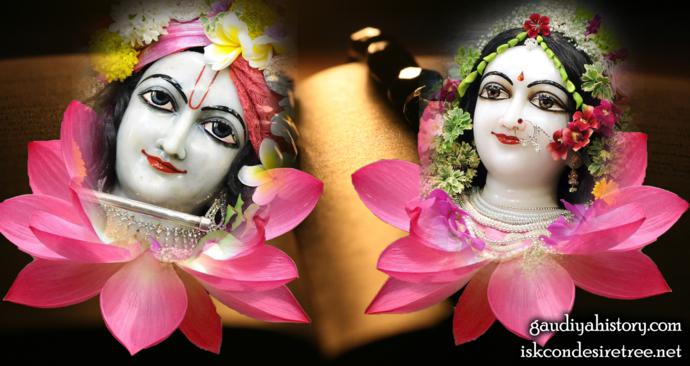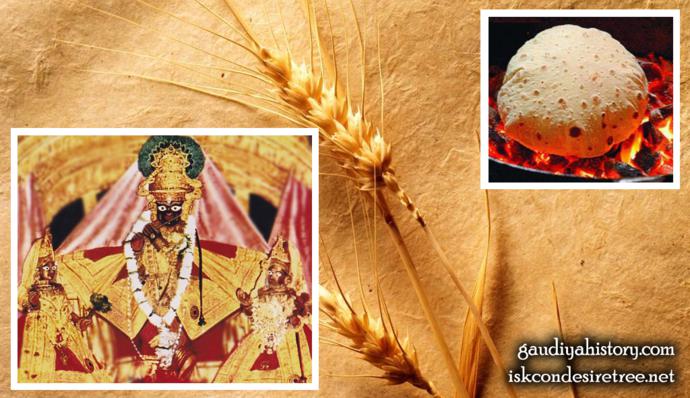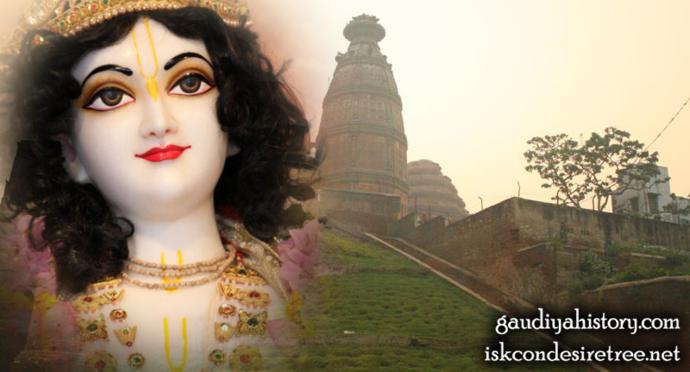
Shri Sanatana Goswami appeared in 1488, five years before Shri Rupa Goswami, in a Sarasvata brahmana family in Bengal. Sanatana and his two brothers, Rupa and Anupama, were always absorbed in bhava bhakti from early childhood. Remembering Vrindavana, they named the forests in which they played after Vraja's twelve forests (Talavana, Madhuvana, Kamyavana, Mahavana). (In the image: Shrila Rupa and Shrila Sanatana Goswamis).
In his youth, Shri Sanatana dreamed that a beautiful brahmana boy gave him a Shrimad Bhagavatam. Feeling ecstatic he awoke. But seeing neither the boy nor the Bhagavatam he felt sad. When Sanatana began his puja that morning, however, Krishna Himself, disguised as a beautiful brahmana boy, came and said, 'Take this Shrimad Bhagavatam from Me, always study it, and you will attain perfection. "
In Krishna-lila-stava, Shri Sanatana Goswami glorifies the Shrimad Bhagavatam: "0 holy Bhagavata, you are my only company, my only friend, and my guru. You are my greatest treasure and my personal saviour. You are the emblem of my highest fortune and the very form of ecstasy. I offer my obeisances unto you."
Forced to submit to the ruling Muslim government, Shri Rupa and Shri Sanatana became ministers and lived at Ramakeli. But their real engagement was teaching shastras which they learned from Vidyavachaspati, brother of Sarvabhauma Bhattacharya. Pandits and brahmanas from all over India came to study under the two brothers. Shri Rupa and Sanatana were acclaimed as the "crest jewels of the Gaudiya Vaishnava scholars." After the Lord visited Ramakeli and freed them, they renounced everything for Lord Gauranga's service. Shri Chaitanya Mahaprabhu ordered Shri Rupa and Sanatana Goswamis to move to Vrindavana and perform four services:
(1) Uncover Shri Krishna's pastime places.
(2) Install Deities, arrange for Their puja.
(3) Compile bhakti scriptures.
(4) Propagate the rules of devotional life.
"Entering Lord Chaitanya's service, they resolutely gave up power, riches, and position to live in Vrindavana as humble beggars absorbed in bhajana. One cannot properly perform Krishna bhajana until one renounces all attachments both internally and externally, and adopts a life of simplicity and humility." (Shri Vraja Mandala Parikrama).

"0 holy Bhagavata, you are my only company, my only friend, and my guru. You are my greatest treasure and my personal saviour. You are the emblem of my highest fortune and the very form of ecstasy. I offer my obeisances unto you." (In the wallpaper: Shri Shri Radha Gopinath, ISKCON Chowpatty, Mumbai, a book).
They traveled extensively through Vraja mandala discovering many lila sthanas of Radha-Madhava. Having no fixed residence, they would catch a few winks of sleep (no more than one and a half hours per day) under a tree or bush. Shri Rupa and Shri Sanatana Goswamis spent all their time writing, discussing Krishna's pastimes, and chanting Krishna's Holy Names.
To maintain himself Sanatana would beg some wheat flour, roll it into a ball by adding a touch of Yamuna water, and drop it in smoldering coals to cook. He would offer this bati (salt-free, baked bread ball) to his Deity of Madana Mohana. Giving up all kinds of material enjoyment, the Goswamis accepted the poorest way of life as mendicants. They ate just enough to maintain their bodies.
The Radha-Madana Mohana mandir established by Sanatana Goswami was the first one opened in Vrindavana by the six Goswamis. Described as "the personal extension of the body of Shri Chaitanya Mahaprabhu," Shri Sanatana is the ideal spiritual master because he gives one shelter at the lotus feet of Madana Mohana. The three Vrindavana Deities (Madana Mohana, Govindaji and Gopinatha) are the life and soul of the Gaudiya Vaishnavas. The Deity of Madana Mohana has the specific quality of helping the neophyte Devotees understand their eternal relationship with the Supreme Personality of Godhead, Lord Shri Krishna.
"Madana Mohana" means Krishna who is so indescribably beautiful that He even attracts Cupid, Kamadeva. Sanatana Goswami is the sambandha acharya who gives us knowledge of our proper relationship with Krishna, And his Deity, Madana Mohana, helps us overcome our attraction for material sense gratification (Cupid) and fix our minds on devotional service.

To maintain himself Sanatana would beg some wheat flour, roll it into a ball by adding a touch of Yamuna water, and drop it in smoldering coals to cook. He would offer this bati (salt-free, baked bread ball) to his Deity of Madana Mohana. Giving up all kinds of material enjoyment, the Goswamis accepted the poorest way of life as mendicants. They ate just enough to maintain their bodies. (In the wallpaper: Shri Madan Mohan, Karoli, Rajastan, wheat and wheat chapati).
Shri Sanatana Goswami spent forty-three years wandering from village to village in Vrindavana. The Vrajavasis would 'affectionately care for him treating him like their father. With patience and concern he listened to their problems. Then he would please all the villagers by his preaching and practical advice on everything from increasing crop yields to solving family quarrels.
"Renouncing all worldly pleasures, Sanatana Goswami was humble, detached, always absorbed in study. Mahaprabhu often said that Sanatana Goswami was His favorite Devotee. As an ocean of love and mercy, Sanatana excelled all other Devotees in his compassion toward the suffering souls." (Bhakti-ratnakar)
In his last years, he left his beloved Deity of Madana Mohana with Krishna Dasa brahmachari, his disciple. He did bhajana on the banks of Manasi Ganga next to Chakaleshvara Mahadeva at Govardhana. Daily he walked the twenty-four mile parikrama (original longer route) of Govardhana Hill. Although he was sixty-five years old, he kept his daily vow of offering 1,008 obeisances to Govardhana Hill and to any Vaishnava whom he met.
Understanding the difficulty of His pure Devotee, Shri Madana Mohana appeared one day and said, "Baba! You are too old. Don't take so much trouble to walk around Govardhana Hill everyday."
Sanatana replied, "This is one of the daily activities of my bhajana: I must maintain it."
"Since you are old," said Madana Mohana, "you may now give up this vow."
Starting to walk again, Sanatana replied, "I will never give up my religious principles."
Sanatana Goswami's firm determination to complete his daily devotional vow pleased Shri Madana Mohana (Krishna). But in the loving dealings between the Lord and His pure Devotee, Krishna's desire to please His Devotee often defeats the Devotee's desire to please Him. So out of loving compassion for His Devotee, Shri Krishna stood on a large flat stone (Govardhana shila) taken from Giriraja. He played His irresistable flute. The Govardhana shila melted in ecstasy, capturing the impression of Krishna's lotus feet.
Presenting this to Sanatana, Krishna said, "If you circumambulate this shila everyday it will be the same as going around Govardhana Hill everyday. You will keep your vow intact and not compromise your religious principles." Seeing that Giriraja Himself (Shri Krishna) had given the shila, Sanatana Goswami gratefully accepted. One can still see that Govardhana shila in the Radha Damodara Temple.
Shri Bhaktivinoda Thakura said in Jaiva Dharma: "Sanatana Goswami was empowered to explain the esoteric aspects of Krishna's manifest and unimanifest Vraja lila." Sanatana Goswami made a significant literary contribution to the Gauidya sampradaya with his Hari-bhakti-vilasa, Brhad-Bhagavatamrta, and Brhad-Vaishnava-toshani.
In the form of Labanga manjari Sanatana Goswami serves Shrimati Vishakha-sakhi in Radha-Madhava's nitya nikunja-lila. Sanatana Goswami's samadhi is behind Radha Madana Mohana's Temple.

Madana Mohana means Krishna who is so indescribably beautiful that He even attracts Cupid, Kamadeva. Sanatana Goswami is the sambandha acharya who gives us knowledge of our proper relationship with Krishna, And his Deity, Madana Mohana, helps us overcome our attraction for material sense gratification (Cupid) and fix our minds on devotional service...The Radha-Madana Mohana mandir established by Sanatana Goswami was the first one opened in Vrindavana by the six Goswamis. Described as "the personal extension of the body of Shri Chaitanya Mahaprabhu...(In the wallpaper: Shri Nityananda Prabhu, ISKCON Brazil, Campina Grande, Madan Mohan Temple, Shri Vrindavan Dham, India).